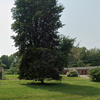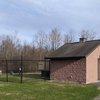Guilderland ZBA approves Pyramid variance for Western Avenue drive-thru
GUILDERLAND — The Guilderland Zoning Board of Appeals in a split vote on May 21 approved a request from Pyramid Management Group to allow for a drive-thru restaurant to be built on a handful of adjacent properties along Western Avenue.
Board members voting in favor of the use variance were Chairwoman Elizabeth Lott, Richard Villa, and Nichole Ventresca-Cohen, while “no” votes were cast by Sharon Cupoli and alternate James Zieno. Kevin McDonald recused himself; he had been party to one of the lawsuits seeking to stop construction of the Pyramid-developed Costco Wholesale project.
The approval allows Pyramid to move forward with a specific development project for the site, a process that involves obtaining a special-use permit and undergoing all reviews associated with the permit application.
Pyramid needed the variance because the five potential project parcels — 1593, 1613, 1615, 1617, and 1621 Western Avenue — are located in the town’s Transit-Oriented Development (TOD) disrict, which, while allowing for food uses, explicitly excludes drive-thrus.
David Aitken, Pyramid’s director of government affairs, was on hand at the May 21 meeting to make the case for why his company’s variance request should be approved.
“In terms of the diligence of this board and steps that we took to prove that the use variance should be considered this evening, there’s a four-prong test that must be passed,” Aitken said, “three of which I believe [are] very straightforward, the fourth of which we engaged independent reviewers in terms of the lack of return, if you will, in terms of the financial proof.”
In order for a zoning board to grant a use variance, an applicant must prove that:
— The property is unable to achieve a reasonable return for any use allowed in the zoning district.
To shore up his argument, Aitken provided the board with a professional appraisal from Northeast Appraisals and a broker opinion from commercial real-estate services giant Cushman and Wakefield.
The site, Aitken said, presented physical challenges for developers: It’s an irregular 2.55-acre parcel; has a substantial 22-foot change in grade, which is further limited by the amount of fill that can be trucked onto the site to level its surface; and it’s bisected by drainage pipes and sewer-line easements.
Aitken told board that, over the past four years, Pyramid had reached out to a number of potential project clients, including a hotel and specialty grocer, but was told the site conditions limited the feasible size of buildings and parking areas.
— Unique circumstances apply to the property.
Aitken argued the hardship was unique due to the presence of an abandoned gas station abutting the site, the significant grade change, the inability to use sufficient fill, and the utility easements traversing the site.
— The hardship was not self-created.
Aitken said that the hardship was not self-created because of the site's physical conditions — its grading and the presence of utilities — and its pre-existing TOD zoning designation.
— The essential character of the neighborhood won’t be altered.
Pyramid’s application stated a drive-thru restaurant wouldn’t alter the neighborhood’s character because the project would be located in a business-zoned district, and that the site is within 650 feet of four non-conforming uses: Dunkin’ and McDonald’s, both of which have drive-thrus, and USA Gasoline and Adirondack Tire.
Public comment
Of the handful of meeting attendees who spoke during the public-hearing portion of the May 21 meeting, just one expressed “strong support of this request for variance,” Brian Carr, who was speaking on behalf of the Guilderland Chamber of Commerce.
Carr reiterated most of the points made by Aitken, while adding, “New investment, of course, will generate new government rent revenues supporting the town, school district, and county, as well as new employment opportunities.” He also said that the “site which surrounds the vacant gas station would be beautified, hopefully resulting in action for that parcel's redevelopment.”
While a drive-thru would generate new revenue, it’s not likely to generate the kind of government funds Pyramid has been so wildly successful in returning to its own pocket. The settlement of a series of tax lawsuits filed against Guilderland between 2020 and 2024 successfully lowered the company’s Crossgates Mall assessed value from $282.5 million to $177 million.
The most recent available public data show the seven parcels that make up Crossgates paid at least $1.37 million less to three local taxing authorities than they did prior to the lowering of the mall’s assessment: In 2025, Crossgates paid $1.25 million in town and county taxes, while its 2022 town and county bill totaled $1.85 million. In 2024, the most recent available data, the mall paid Guilderland schools $3.6 million in taxes. Two years earlier, that figure was $4.5 million.
The most extensive critique of Pyramid’s variance request came from Robyn Gray who chairs the Guilderland Coalition for Responsible Growth.
Gray said Pyramid wasn’t “a good neighbor to Guilderland,” referring to the approximately 10 tax certiorari cases it’s filed against the town in addition to a more-recent suit involving the industrial development agency’s use of eminent domain to acquire and relinquish to Pyramid— for $686,000 — roads located on the future Costco site.
Gray argued that the proposal directly contradicts the intent of the zoning district in which the property is located. She said that TOD zoning was intended to promote walkability, not “drive-ins,” in the district, which is bounded by the I-87 offramp to the east, Western Avenue to the south, Rapp Road to the west, and the city of Albany to the north.
Allowing a drive-thru restaurant encourages vehicular use, creates additional traffic, and reduces walkability, Gray said, each of which are “completely contradictory” to the TOD district’s intent.
She also challenged the comparisons made by Pyramid regarding the existing nearby drive-thrus. “Dunkin’ Donuts is not in the TOD and should not be considered as something that can be given as an example in this,” Gray observed incorrectly; the town’s online mapping shows the zoning for 1573 Western Ave. as part of the TOD.
“McDonald's was there long before the area was rezoned to a TOD, so no exception should be given for a drive-thru in this particular area,” said Gray.
Gray said another drive-thru would add to the already woeful traffic in the area.
“In terms of traffic, when you look at the amount of traffic that is on Western Avenue at this point, right now, you get between 38,000 and 55,000 cars per day, OK?” Gray said. “It’s closer to 55,000 cars cars from the Northway up to the Crossgates Mall Road, which is “exactly where this is going to be.”
She added, “This does not include the traffic that’s going to be generated because of Costco. So I think having a really impartial traffic study” is important, not one from a consultant who “will basically write what you want them to write.”
The closest available New York state traffic data, from the corner of Western Avenue and Church Road, shows that, between 2017 and 2023, the intersection had a median daily traffic count of about 42,200, while the same-dated data from the I-87/I-90 interchange near the Albany-Guilderland line had a median daily count of approximately 61,600.
Board views
Just before Lott called for a vote on Pyramid’s variance application, members expressed their views on granting the request.
Zieno said, “I would just say that you’ll see my vote in this in a minute, but a drive-thru restaurant is specifically one of the prohibited uses of transit-oriented development and seems, in my opinion, to run completely contradictory to the intention of transit-oriented development.”
The purpose of the TOD zoning, Zieno said, is “to promote more walkability, to promote more housing ability, more public transit,” and while “there weren't that many things specifically prohibited,” a drive-thru is one of them.
Cupoli had concerns with the practical implications of the proposed development, citing the feasibility of pedestrian access to the site, specifically the difficulty of crossing Western Avenue, a busy state highway with multiple lanes of traffic.
Cupoli also questioned whether individuals staying at nearby hotels, or visiting the yet-to-be-built cancer treatment center, or residing in apartments three-quarters to 1.5 miles from the site would realistically, given the distances and impediments involved, choose to walk to a restaurant at the proposed location.
But she also noted, while the idea of the TOD’s zoning was to create a non-drivable community, in this specific instance, because of its location and characteristics, the site “doesn’t lend itself to that idea.”
Explaining her decision, Lott walked through the four-prong test applied to use-variance requests.
She said that the evidence presented indicated it was not feasible for Pyramid to realize a reasonable return under the property’s currently-permitted use, citing as evidence the appraisal and broker’s opinion, which detailed the parcel's physical challenges including its irregular shape; its substantial topographic variation, with some areas 22 feet below the grade of Western Avenue; and the presence of sewer line easements and drainage pipes bisecting the property.
She also noted that the town’s water-wastewater department imposed limits on the amount of fill that could be brought onto the site, which are due to concerns that excessive fill weight and compaction could damage the existing underground infrastructure or impede future access for maintenance.
The topographical challenges and fill restrictions, Lott said, saw a hotel and specialty grocer decline to develop the site. Given these impediments, she concluded that a drive-thru restaurant, with its smaller building footprint and less-extensive parking, appeared to be the only feasible option for development that could potentially yield a reasonable return.
In explaining her reasoning for the three remaining prongs — whether the character of the neighborhood would be altered, if the hardship was self-created, and whether unique circumstances applied to the property — Lott largely cited Pyramid’s earlier arguments.



